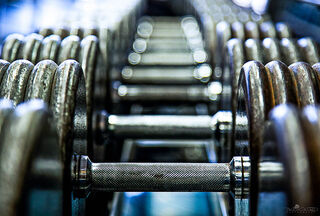Will Reopening Gyms Improve Our Well-Being or Put Us at Risk?
(Posted on Monday, August 10, 2020)
Is it better for our health to return to the gym or stay away?
For months, people have been deprived of a crucial outlet for relieving stress and improving wellness: their local gym. Now that lockdowns are lifting, and in some places, the disease receding, many are itching to ease back into their intense cardio and weightlifting routines.
But with COVID-19 cases surging across the country, we must ask ourselves: Is it really safe to reopen gyms?
Gyms typically house all types of bacteria. One study shows that free weights can have 362 times more bacteria than a toilet seat. This bacteria can not only make people sick, but it can also cause skin, ear, or eye infections. With COVID-19 potentially circulating in gyms, people could be even more at risk.
Gyms: a place to get fit or get sick?
According to a group of Korean researchers, the humid airflow containing people’s sweat, breath, and, therefore, their bacteria circulating in gyms will create an environment where minute respiratory droplets easily spread. These aerosols, which remain airborne for up to three hours, can spread COVID-19, which means virus transmission is more likely to occur in these confined training facilities than many other indoor settings.
Gyms like Planet Fitness and O2 Fitness Clubs are taking several precautions to reduce this heightened risk of transmission. These include periodic equipment disinfection, mandated or recommended mask-wearing and handwashing, temperature checks for workers, and limits on the number of people in the facility at any given time.

While certainly well-intentioned, these protocols in no way constitute a foolproof safeguard against the virus. As gymgoers take turns running on treadmills or using different weight machines, they’re bound to interact with the same bacteria and germs others have spread by touch, making the periodic equipment disinfection an inadequate protocol. Steam-filled locker rooms packed tightly with sweaty people present another problem and, in fact, could become more dangerous than the training facilities themselves, due to the confined space and limited airflow. As a result, social distancing becomes impossible and ineffective, while the risk of transmission becomes greater.
Moving exercise out of the gym and into the home
It wasn’t easy to maintain a fitness regimen during the lockdown, and even with lockdowns lifting, it isn’t easy now. That said, there are plenty of ways for people to take care of themselves physically and mentally without going to a gym, and as long as COVID-19 remains a threat, these alternatives are well worth considering.
Light exercise is relatively easy. If the weather is nice, going for a walk in the neighborhood is a great way to get those steps in, as well as a breath of fresh air. Other options are buying a mat to do yoga in the backyard or doing ab exercises in the living room.
There are options for more intense physical activity, too. For cardio, go on a run in a somewhat empty park trail, or if a hill is nearby, doing incline sprints is a great way to work up a sweat quickly. For bodyweight exercises, try combining squats, planks, crunches, lunges, burpees, and wall-sits in lieu of machines and free weights. By combining cardio workouts with bodyweight exercises, you create a high-intensity, serious workout that requires minimal equipment, eliminating the necessity to go to the gym as the virus continues to pose a threat.
If weights are a must for your fitness routine, but you don’t have any at home and can’t purchase them online, figure out a creative alternative. For example, you can use household items as weights: filled milk or water gallon jugs, bags of sand or soil, large bottles of laundry detergent, a backpack filled with books, or even paint cans.
If gymgoers need the motivation to exercise, they could set a virtual workout time with their friends and work out on FaceTime or other similar platforms together. Not only will this motivate them to work out during that time, but it will provide them with the familiar gym environment of people working towards the same goal of staying in shape.
Another option to motivate people to work out is watching YouTube videos of fitness gurus explaining and doing exercise circuits. In addition, they can enroll in one of the many online free fitness programs or apps currently available. Some of these programs create personalized workout plans and may also provide meal recipes to follow to stay healthy.
With these effective options, it is easier to not only stay motivated and active but also stay safe in the comfort of one’s home. We should truly consider whether reopening gyms right now is in our best interest, especially with easy access to effective alternatives for working out at home. While gyms are a great place to blow off steam and stay fit, is it really the best idea to go in hopes of improving our mental well-being by putting our health on the line?

